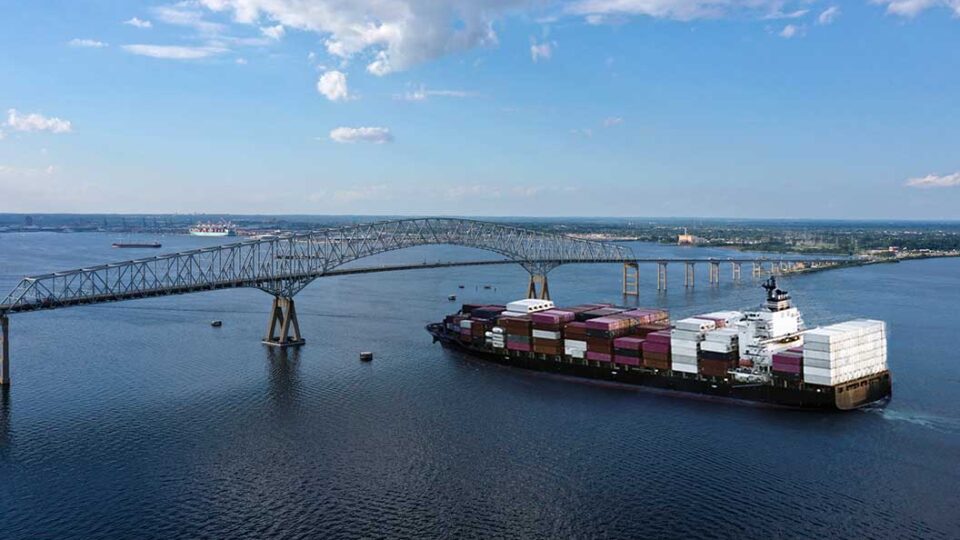
Baltimore Bridge Disaster Is Set To Disrupt Port Operations
On Tuesday, March 26, 2024, a pillar on the Francis Scott Key Bridge was struck by a container ship leaving the Port of Baltimore. This caused a large section of the bridge to collapse into the Patapsco River. Due to the debris blocking entry into the port, many experts believe this unfortunate disaster will disrupt the supply chain.
What Caused the Baltimore Bridge Collapse?
Around 1:30 a.m. on Tuesday, March 26, 2024, a Singapore ship called the Dali collided with a pillar of the Francis Scott Key Bridge. The vessel was carrying 4,900 containers.
A video circulating online shows the ship losing and regaining power just before it makes contact with the bridge. Smoke can also be seen pluming from the vessel. Just after impact, a portion of the bridge collapsed into the Patapsco River.
The crew of the vessel notified authorities of a power issue and issued a mayday before striking the pillar. Preliminary investigations have pointed to this incident being an accident.
How Long Will Vessel Traffic Be Suspended?
The Port of Baltimore announced the suspension of inbound and outbound vessel traffic. However, authorities announced that trucks are still being processed inside port terminals.
Currently, there is no indication for how long vessel traffic will remain suspended. Aside from debris cleanup, there are ongoing efforts to rescue and recover those who were on the bridge when it was struck.
For now, ships won’t be able to pass in or out until bridge debris is cleared from the Patapsco River.
Where Will Vessel Traffic Truck Freight Be Redirected?
Imports that were originally routed to the Port of Baltimore will be redirected to other ports along the Eastern Seaboard
This includes:
- Port of New York/New Jersey,
- Port of Norfolk, VA
- Port of Savannah, GA
- Charleston, SC
- Boston, MA
These ports are larger than the Port of Baltimore, but the redirected shipments are likely to still cause delays. The Francis Scott Key bridge is used to support a portion of I-695.
According to the Maryland Transportation Authority, I-695 Outer Loop is closed at MD 10 (exit 2) and Inner Loop MD 157/Peninsula Expressway (exit 43).
MDTA recommends motorists and truckers use the Fort McHenry Tunnel I-95, or the Baltimore Harbor Tunnel I-895 as alternate routes when traveling to and from the port.
Vehicles that are 13 feet, 6 inches in height, or 8 feet wide won’t be able to use the Baltimore Harbor Tunnel on I-895. The Fort McHenry Tunnel along I-95 limits vehicle dimensions to 14 feet, 6 inches in height and 11 feet in width.
The city of Baltimore doesn’t allow hazardous materials to enter any of its tunnels. For semis carrying this type of cargo, MDTA recommends they use the western section I-695 to circumvent tunnels.
The Port of Baltimore’s Importance To East Coast Vessel Traffic
According to Maryland State Archives, the Port of Baltimore was responsible for handling 11.7 million tons of general cargo in 2023. This is a new record from the 11.3 million tons the port handled in 2022.
In 2023, the Port of Baltimore also handled 52.3 million tons of international cargo that was valued at $80.8 billion. When compared to U.S. ports nationally, it ranks in 9th place for total dollar value and tonnage of cargo.
The Port handles almost 1,800 trips per year from over 50 different ocean carriers. Economically, this port is very important to the state of Maryland.
- Baltimore’s port supports more than 15,000 jobs and supports more than 140,000 others
- The port is responsible for generating $3.3 billion in personal income each year
- It also brings $400 million in annual tax revenues
The current disruption is likely to heavily impact vessel traffic and the economy of the state.
Updates for March 29th
The Mediterranean Shipping Company S.A. (MSC) and other ocean carriers have started terminating the delivery of their containers. The containers will be diverted to a new port, but post dropoff arrangements have been cancelled.
As a result of these decisions, importers and shippers will have to make new arrangements to get their containers out of the port their freight was directed to. However, Maersk has offered to transport containers on board of the vessel that struck the bridge from the alternate ports.
Ports that will be receiving freight redirected from Baltimore report they’ll be able to handle the increase of cargo. Logistics companies are offering rail and semi-truck delivery as well.
Nonetheless, carriers will be diverting their fleets to different ports. This can contribute to the delays caused by this incident. Containers are only permitted to sit at a port for a certain amount of time before demurrage charges start to hit.
R+L Global Logistics Can Help You Navigate the Challenges of This Unfortunate Disaster
At R+L Global Logistics, we have a team of import and drayage professionals. If your cargo arrived at the Port of Baltimore before the Francis Scott Key Bridge collapse, we can get it out of the port with our drayage services.
Our importation specialists can keep you updated on the progress of cargo as it’s redirected to another port. To get started with our services, simply reach out by calling us at (877) 510-9133.
